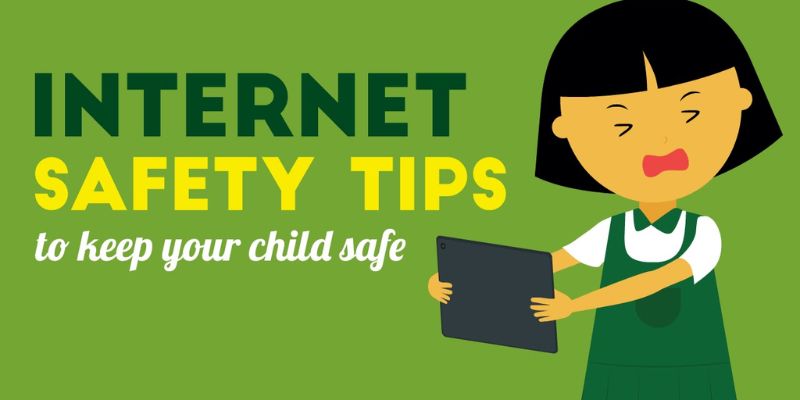Navigating the web can feel like steering a ship through wild seas—especially when your kids are on deck. Tips to keep kids safe online start right here. As a vigilant parent, knowing how to create a haven in the digital sprawl is crucial. I’ll show you how to craft a robust safety net around their online activities so you can worry less. Let’s dive in, transform your digital parenting skills, and rest easier tonight.
Establishing a Safe Digital Environment for Your Child
Setting Up Parental Controls for Devices
You want your kids to explore and learn online, but safety comes first. Parental controls are like a digital playpen. They keep your kids from wandering into the wrong places. Most devices come with built-in controls you can turn on.
How do you set up parental controls? Start by checking the settings on each device. You’ll usually find a “parental controls” section. Here, you can choose what content your child can see and what they can’t. You can limit screen time, too.
Some devices may ask you to create a child’s profile. This lets you tailor rules just for them. You can block websites you don’t want your child to visit. You can also control who they talk to and what they can download.
With these controls, you can track your child’s online moves. You can see their history to know if they’re following internet safety rules.
Choosing Child-Friendly Browsing and Kid-Safe Search Engines
What makes a browsing option safe for kids? A child-friendly browser or search engine keeps out bad stuff. It filters the web, only showing what’s ok for your child to see.
You want your child to only find age-appropriate online content. So, you go for kid-safe search engines. These search engines are just for kids. They don’t show results that are for adults.
Normal browsers might show everything. But these special browsers make sure your kids won’t see things they shouldn’t. They use pictures and voice search, too. So even little kids who can’t type can find what they want safely.
When choosing such a browser, look for one that’s easy to use. It should have safety features up front. Some even have fun themes for kids. They make learning about internet privacy settings early on easy and engaging.
Remember, you’re not just blocking bad content. You’re also teaching your child about protecting personal information online. Teaching cybersecurity basics to kids helps a lot. They learn to recognize what’s safe to click on, like links and ads. It keeps them from risks like sharing photos or child identity theft.
Parental controls and child-friendly browsers don’t do it all, though. You need to talk to your child about safe online gaming and the risk of meeting strangers. Use trusted online educational resources to show what’s good and bad.
Control what your child can access, and make sure they understand why rules are in place. This gives them the power to stay safe on their own. Plus, they can learn and have fun at the same time. So use these tips to make your home a haven for digital exploration.

Educating Children on Online Safety and Digital Etiquette
Cyberbullying Prevention Strategies for Minors
Kids face mean behavior online just like at school. Teach them to stand tall. Say to them, always tell someone if they’re being bullied online. That’s step one. Next, they must know it’s not their fault. Reassure them you’re there to help. Show them how to block bullies on their apps and games. Also, remind them to be kind online. Explain that words can hurt.
We must show kids safe ways to act online. They should know when to step away from the screen. Teach them to share only kind words. If someone’s mean, they don’t have to stay silent. They can come to you. Together, you’ll find a way to make it better. Staying safe online means being smart and kind.
Introducing Age-Appropriate Online Content and Digital Footprint Education
Kids are curious. The internet is full of wonders and dangers. We guide them on what’s good to see. Start by setting up kid-friendly searches. This protects them from bad stuff. You can find lists of good sites for kids. Share them with your kids. Help them find fun, safe spots online.
Teaching kids about digital footprints is vital. Explain that everything they share stays online. It can be used in good and bad ways. Help them think before they post. They should ask, “Would I show this to my grandma?” If not, maybe don’t share it. Keeping personal info private is important too. Say “no” to sharing addresses and birthdays online.
Online games should be just right for their age. Fun and safe, not scary or risky. Make strong passwords together. It’s like a secret fort for their stuff online. Show them how to pick a tough one. It’s a big step to keeping them safe.
Remember, kids learn fast, especially with your help. Talk about these things often. Be clear and kind. They will get it. Learning to stay safe online is like learning to ride a bike. At first, they need help. Soon, they’re off, riding safely with you cheering them on.

Monitoring and Participating in Your Child’s Online Activities
Utilizing Mobile Apps for Kids’ Safety
Today, we are in a digital age where kids often hold gadgets before they can even read. As a parent, keeping your child safe online is just as important as in the real world. Start by exploring mobile apps designed for children’s safety. When you pick the right app, you get to check what your child sees and does on their device. You can control the time they spend online and even the sites they visit. Some apps can block bad stuff like violence or adult content. They make sure everything is okay for your child’s age.
But not all apps work the same. It’s smart to try a few and see which one fits your family best. Look for apps with easy rules you can set, like what times of day your child can go online or which games are okay to play. The best apps can also tell you if someone strange tries to talk to your child, keeping them safe from online dangers.
Implementing a Family Internet Safety Plan
Now let’s talk about a family internet safety plan. This is like a set of house rules, but for the internet. Sit down and chat with your kids about what sites are safe and which are no-go zones. Rules should be clear and fair for all. For example, you might decide that personal info stays private, or that downloads need your okay first. Setting up rules helps your child understand what they should do if they find something odd or feel unsure.
It’s also key to talk about what to do if they come across a bully online. Teach them to come to you without fear if something makes them feel bad. That’s where trust plays a big role. Also, remind kids not to share photos without asking you first. It’s a simple yet crucial step to protect their identity.
Having a plan means everyone knows what to do. This avoids panic when things go wrong. Make sure to write down your safety rules and put them where you can see them. This way, they’re always fresh in mind for you and your kids.
Being part of their online world doesn’t mean spying. It shows you care about their safety, much like teaching them to look both ways before they cross the street. By using these tips and having open talks, you can help shape a fun and secure online journey for your little ones. And remember, each step you take today can make a big difference in keeping their digital future safe.

Fostering Open Communication and Healthy Online Habits
Conversation Starters About Internet Safety
Let’s talk about talking! Yes, you heard it right. To keep kids safe online, we need to chat with them. But how? Start with a game. Ask them to name their favorite YouTube video. Then ask, “Who else can see what you watch?” This can lead to a bigger talk about who’s out there in the online world. Next, act like a detective. “How do we know if someone is a good guy or bad guy online?” Discuss clues like strange messages or odd friend requests. Always use words they get, like “safe” and “unsafe,” not “malware” or “phishing.”
Here’s a big point: teach your kids to ask before they click. Yep, anything they want to download, buy, or join, they should check with you first. That way, you can guide them on what’s wise. Explain “why” so they learn too.
Establishing and Managing Screen Time for Youngsters
We love our screens, don’t we? But too much is too much. Let’s set rules for screen time. Start with a timer. When it rings, time’s up! Make sure there’s time for homework, play, and family. Talk about why balance matters. Our brains need breaks from screens to stay sharp.
Try this: create a chart with your child. Let them help set screen time limits. This makes them part of the plan. Have slots for TV, games, and learning. Then, promise a reward for sticking to the plan. Could be extra storytime or a favorite snack.
Remember to take breaks. Stretch, hop, or just chat between screen times. This helps little eyes and bodies refresh. Keep screens out of bedrooms and away from meal times. Why? To help kids sleep well and enjoy family talks. Lastly, be a role model. Show them how you balance your screen time, so they can follow your lead.
In this post, we covered how to make the internet safe for kids. From setting up controls on devices to picking safe places online for kids to explore. We learned about stopping cyberbullying and teaching kids about leaving marks online. We checked out apps that keep kids safe and how families can make plans for safety online. We talked about talking to kids to help them learn and make rules about time in front of screens.
To wrap it up, the web can be full of wonders but also risks. I hope this guide helps you guide your children in using the internet smartly and safely. It’s all about balance and staying clued in. Keep the dialog open, and keep learning together. This way, you’ll create a digital world that’s not only safe but also enriching for your child.
Q&A :
What are some essential tips for keeping kids safe on the internet?
Keeping kids safe online involves a multi-faceted approach that includes open communication, education on potential dangers, and the use of parental controls. Teach kids to keep their personal information private, to recognize and report inappropriate content or contacts, and to use strong passwords. Encourage them to come to you if they encounter something worrisome or questionable.
How can parents monitor their children’s online activities effectively?
Parents can monitor their children’s online activities by setting up parental controls on devices, using monitoring software, and keeping computers in shared family spaces. Regularly discuss the content they’re accessing and who they’re interacting with online. It’s essential to balance supervision with respect for their privacy and independence as they grow older.
What are the best parental control tools for managing kids’ online usage?
There are several effective parental control tools that help manage kids’ online usage. These include software like Qustodio, Net Nanny, and Norton Family. These tools can filter content, set time limits, track location, and monitor social media interaction. Choose a tool that suits the specific needs of your family and the age of your child.
How can I educate my child about online safety in an age-appropriate way?
Educating your child about online safety starts with simple conversations that are age-appropriate. For younger kids, discuss the basics of staying safe, like not talking to strangers or sharing personal information. With older children, delve into more complex topics like cyberbullying, digital footprints, and online scams. Make use of resources like interactive games and educational websites designed for kids.
What steps should I take if my child encounters online dangers?
If your child encounters online dangers, act calmly and promptly. Assess the situation to understand the level of threat and discuss it with your child, listening carefully to their concerns. If necessary, report the incident to the appropriate authorities, such as the website administrators, school officials, or even law enforcement. Provide support to your child and reinforce safety practices for the future.



